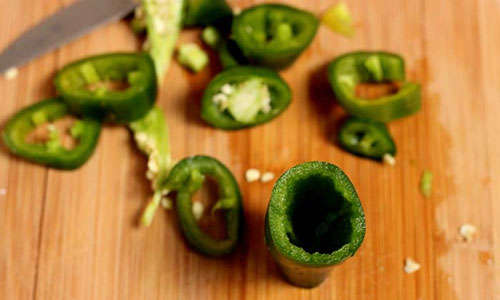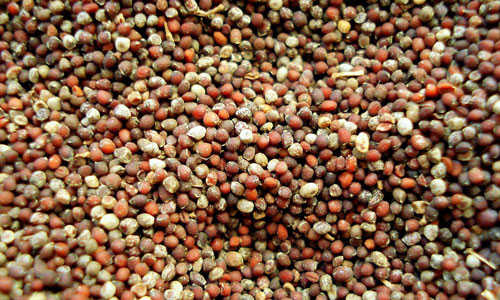My Hands Are Burning
If you're going to cut jalapenos, wear gloves. I didn't, and I had a pretty rough night. Here's my story.

So why did jalapeño peppers make me want to cut my fingers off, anyway?
Now, the thing with hot peppers is that there's no discernible rise in temperature when you have them. It just feels like there is.
And it's because of a chemical that does some pretty fancy tricks on our brain. Capsaicin, which is common in all hot peppers, essentially tricks your tissue into thinking that it's being burned, by driving a certain protein receptor crazy.
"TRPV1 receptors are usually activated by heat, but the capsaicin tricks them into reacting as though they’re in the presence of something hot even though there’s no actual rise in temperature," Nadia Arumugam explained in a 2012 Slate piece.
To a degree, this can be desirable—the heat has some significant benefits for the taste of the given food. But taken too far, it can literally create a psychoactive high.
16M
The estimated number of Scoville units pure capsaicin, the heat-causing element of most peppers, has, according to the Scoville Scale, a measurement of the heat peppers tend to have. If you would like to test this perfected heat out for yourself, they sell the stuff over this way.
How five other forms of life handle hot peppers
- Most mammals can't stand capsaicin, due to the fact that they have the same receptors that humans do. That doesn't extend to every mammal, however. The guys from Mythbusters once did a test with habanero peppers and sharks, and found it didn't have an effect whatsoever.
- Birds aren't really affected by capsaicin at all—it doesn't really have a flavor for them whatsoever, because they don't have the same type of pain receptors that mammals do. That means they can largely eat hot peppers, no problem.
- When it comes to insects, hot peppers are downright toxic for many of them—which means that if you want to create an insect repellent that's completely natural, a pepper mix can do the trick.
- Besides peppers, capsaicin is known for having a negative effect on the growth of other kinds of plants, including lettuce and alfalfa sprouts.
- Kermit can have as many hot peppers as he wants. According to a 1985 study published in Naunyn-Schmiedeberg's Archives of Pharmacology, capsaicin doesn't cause adult frogs any pain, and it has a modest effect on the frogs, at best.
"Your heart will race, you'll sweat. You might shake, you might throw up. But once it gets into your blood stream and gets into your brain the capsaicin releases the same endorphins that narcotics do. So you get a euphoric feeling."
— Ed Currie, a resident of Rock Hill, S.C., describing a pepper he's grown to an NPR affiliate called Smokin' Ed's Carolina Reaper. At the time of the 2011 interview, reporter Marshall Terry tasted the pepper and described a fairly harrowing experience. In 2014, Guinness World Records confirmed that the pepper is the world's hottest. Currie owns a hot sauce company fittingly called "Pucker Butt Pepper Company."

Even if you can handle a habanero, mustard might be too much for you. Here's why
Capsaicin isn't the only chemical out there that can have a fiery effect on your body.
There's a whole 'nother realm of condiments—your mustards, your horseradishes—that include the chemical allyl isothiocyanate, a different kind of heat that holds a pungent punch you'll often feel in your nostrils.
This punch, which can often feel a bit overwhelming in a completely different way from a hot pepper, can often have the side effect of offering temporary relief during a cold. But don't be fool, Mental Floss says.
"Capsaicin and allyl isothiocyanate’s irritation can cause the dilator naris muscle in your nose to temporarily allow more air to enter," the magazine's Matt Soniak explains. "Receptors in your nose then tell your brain that you’re breathing easier. It’s all an elaborate ruse, though, and when the effect of the heat wears off, you’re back to your old stuffy self, with plenty of extra snot brought on by your meal to boot!"
Wasabi gets all the buzz for being hot in the brassica family of plants, but if you really wanna test your palate, try your hand at some different kinds of mustard—Serious Eats notes that the kinds most likely to pack the spice are variations of black mustard or versions sold in powdered form.
$160
The cost per kilogram of purchasing wholesale wasabi plants. (Alibaba sells it, because of course they do.) The reason it's so expensive? To put it simply, it's really difficult to properly grow well. Because of the challenge that growing pure wasabi creates, most of the stuff you have with your sushi is actually a green paste made of food coloring, mustard, and horseradish. The imitation stuff is actually a bit spicier, the BBC notes.
So anyway, back to my tale of the sore fingers. The crazy part about what happened is that my fingers wouldn't stop being sore, and nothing would work. I managed to wince through the pain long enough to do a Google search or five on home remedies that would help ease the pain, and they were a bit all over the place.
What I read were tons of horror stories.
"I barely slept two hours last night because my hands were burning so badly," one Chow user wrote of the habanero that came to haunt him. "I was literally crying and contemplating a trip to the emergency room because the pain was so excruciating."
"The burning is so bad that I am sitting with my hand in a pot of cool water," a Physics Forum reader wrote.
The water was of no help. See, capsaicin isn't water-soluble, which means that no matter how many times you wash your hands with soap, the burn sticks around, ensuring that you'll be in pain for hours. You're better off with milk or oil.
The eventual solution that I ended up using involved a combination of rubbing oil and salt in my hands. That wasn't the greatest solution in the world, but hey—at least I got to sleep last night.
Next time, I'll leave the work to the professionals.
:format(jpeg)/2018/11/z7ssiz9r4vixzmwbbnqm.gif)
/2018/11/z7ssiz9r4vixzmwbbnqm.gif)

/uploads/ernie_crop.jpg)